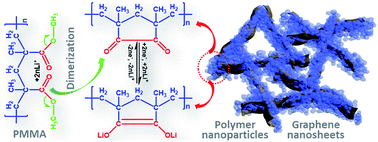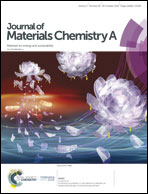A facile solvothermal polymerization approach to thermoplastic polymer-based nanocomposites as alternative anodes for high-performance lithium-ion batteries†
Abstract
Conventional inorganic electrode materials for lithium-ion batteries (LIBs) face inherent limitations in electrochemical performance, natural resources, environmental issues, mechanical robustness, and cost. Organic redox polymers have recently attracted considerable attention as potential low-cost alternative electrodes for green LIBs; however, they are often employed as cathode materials. Herein a simple one-pot solvothermal polymerization approach was developed to produce graphene/chemically crosslinked poly(methyl methacrylate) (Gr/c-PMMA) composites as robust anodes for high-performance LIBs. As control samples, linear PMMA and pure c-PMMA are also solvothermally polymerized without and with the addition of a crosslinker, respectively, in the absence of graphene oxide. Such thermoplastic PMMA-based materials as anodes for LIBs exhibit a pair of stable redox peaks at 0.79 and 1.02 V over a potential range of 0.01 to 2.5 V, due to their highly reversible lithiation/delithiation of the in situ generated 1,2-cyclopentanedione active units. The reversible capacities of PMMA, c-PMMA, and Gr/c-PMMA anodes are 97, 147, and 206 mA h g−1 at 20 mA g−1, respectively. After increasing to 400 mA g−1, the Gr/c-PMMA anode manifests a capacity retention of 82%, higher than those of c-PMMA (72%) and PMMA (38%) anodes. Moreover, Gr/c-PMMA delivers a high capacity of 159 mA h g−1 after 1000 cycles at 400 mA g−1. Notably, compared to PMMA, the better performance of c-PMMA can be attributable to the chemical crosslinking induced-formation of porous networks consisting of smaller nanoparticles (∼50 nm) for c-PMMA than those of PMMA (∼100 nm). The incorporation of uniformly dispersed graphene into c-PMMA enables the creation of 3D conductive networks with interconnected porous channels, thereby providing the efficient electrochemical activity of Gr/c-PMMA while retaining the structural integrity during cycling. This, in turn, results in a large specific capacity, a high rate capability, and a long-term cycling stability. These findings may provide new insights into the exploration of low-cost commercial plastics for rechargeable batteries as well as the possibility of other high added-value energy applications by capitalizing on recyclable plastics.



 Please wait while we load your content...
Please wait while we load your content...